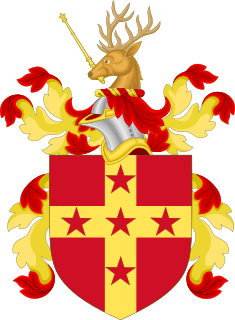Related Research Articles
Master of the Mint is a title within the Royal Mint given to the most senior person responsible for its operation. It was an important office in the governments of Scotland and England, and later Great Britain, between the 16th and 19th centuries. Until 1699, appointment was usually for life. Its holder occasionally sat in the cabinet.

The Randolph family is a prominent Virginia political family, whose members contributed to the politics of Colonial Virginia and Virginia after it gained its statehood. They are descended from the Randolphs of Morton Morrell, Warwickshire, England. The first Randolph to come to America was Henry Randolph in 1643. His nephew, William Randolph, later came to Virginia as an orphan in 1669. He made his home at Turkey Island along the James River. Because of their numerous progeny, William Randolph and his wife, Mary Isham Randolph, have been referred to as "the Adam and Eve of Virginia." The Randolph family was the wealthiest and most powerful family in 18th-century Virginia.
Dalrymple is a surname, originating with the toponym of Dalrymple, East Ayrshire, Scotland. Used as a surname denoting origin since the 16th century, it was carried by the viscounts of Stair, East Ayrshire in the 17th century . It also occurs as a commoners' surname since at least the 18th century. It has rarely been used as a given name since the later 18th century.

The Livingston family of New York is a prominent family that migrated from Scotland to the Dutch Republic, and then to the Province of New York in the 17th century. Descended from the 4th Lord Livingston, its members included signers of the United States Declaration of Independence and the United States Constitution. Several members were Lords of Livingston Manor and Clermont Manor, located along the Hudson River in 18th-century eastern New York. The other two most influential New York dynasties of the 18th and 19th centuries were the Schuyler family and the Clinton family.
The High Sheriff of Kerry was the British Crown's judicial representative in County Kerry, Ireland from the 16th century until 1922, when the office was abolished in the new Free State and replaced by the office of Kerry County Sheriff. The sheriff had judicial, electoral, ceremonial and administrative functions and executed High Court Writs. In 1908, an Order in Council made the Lord-Lieutenant the Sovereign's prime representative in a county and reduced the High Sheriff's precedence. However the sheriff retained his responsibilities for the preservation of law and order in the county. The usual procedure for appointing the sheriff from 1660 onwards was that three persons were nominated at the beginning of each year from the county and the Lord Lieutenant then appointed his choice as High Sheriff for the remainder of the year. Often the other nominees were appointed as under-sheriffs. Sometimes a sheriff did not fulfil his entire term through death or other event and another sheriff was then appointed for the remainder of the year. The dates given hereunder are the dates of appointment. All addresses are in County Kerry unless stated otherwise.
References
- ↑ "Fellows of the Royal Society". London: Royal Society. Archived from the original on 2015-03-16.